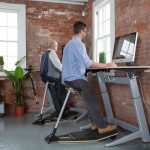If you have low back pain or neck pain, then you understand how debilitating this can be. The symptoms coming from your back may make it difficult to sit, stand, bend, walk, and perform basic day-to-day tasks.
A visit to your physical therapist is a good first step in caring for your back or neck pain. He or she can assess your situation and can offer specific exercises and strategies to help decrease your pain and improve your mobility.
Your physical therapist will likely prescribe back exercises to help improve your overall range of motion and strength in your back. This can help you get moving better, and exercises performed regularly may help you prevent future episodes of back and neck pain.
Postural correction is also an important component of any physical therapy program for low back or neck pain. Attaining and maintaining proper posture can help keep pressure off of spinal joints and discs and can help relieve pain that is coming from your back.1
A simple exercise to perform to help train your body to recognize proper posture is called the slouch-overcorrect procedure. It can help you understand what it feels like to have your spine in the optimum position to maintain proper posture. This can help decrease back pain, and proper posture may be one way to help keep the pain from coming back.
SET OF EXERCISES №1 TO IMPROVE POSTURE. ROUND BACK (SLOUCHING)
The Slouch-Overcorrect Procedure
:max_bytes(150000):strip_icc():format(webp)/slouch-56a72a8b5f9b58b7d0e77fb1.jpg)
Before starting any exercise program for your back, you should visit your healthcare provider or physical therapist to ensure exercise is safe for you to do.
To start the slouch-overcorrect exercise, sit in a chair with your back unsupported. Then, slowly allow your back to slouch down into a forward flexed posture. Your movement into this position should be slow and purposeful.
After you slouch down, hold this position for one to two seconds, then move on to the overcorrect portion of the procedure.
Keep in mind that if you start to feel pain while slouching, you should return to the upright position and try to maintain it.
SET OF EXERCISES №2 TO STRENGTHEN THE MUSCLES OF THE BACK, NECK, STABILIZE THE SHOULDER BLADES OF THE UPPER SPINE
The Overcorrect Position of the Slouch-Overcorrect Procedure
:max_bytes(150000):strip_icc():format(webp)/overcorrect-56a72a8c5f9b58b7d0e77fb4.jpg)
After you spend one or two seconds in the slouched position, it is time to perform the overcorrect position of the exercise. To do this, try to sit up with an upright posture as straight as you can. It is helpful to keep your feet flat on the floor.
When you sit upright, a forward curve in your spine, called lordosis, should be accentuated.2 Your posture should be so upright that you feel unnatural, and you should feel a slight strain on your lower back, neck, or shoulders.
Once you are in the full upright and overcorrected posture, hold the position for 1 to 2 seconds, and then slowly release your posture about 10 to 15 times. You should feel the stress and strain that was in your neck, shoulders, or lower back go away. The forward curve in your lower back should still be present, just not fully accentuated.
You should now be sitting in proper posture for your back. This position may feel unnatural at first, but as you progress with the slouch-overcorrect procedure, it will start to feel more and more natural. Once you have attained proper sitting posture, the use of a lumbar roll or small pillow behind your lower back for support can help keep your spine in an optimum position.
You can repeat the slouch-overcorrect procedure for 10 repetitions, and it can be performed several times each day to practice attaining and maintaining proper sitting posture.
SET OF EXERCISES №3 TO IMPROVE POSTURE. FLAT BACK
Summary
Exercises and proper sitting posture are proven methods to help decrease low back and neck pain.1 By performing the slouch-overcorrect procedure, you can teach your spine to be in an optimum posture to help decrease and eliminate pain and keep the pain away.
Video: “Exercises for the Rehabilitation of Posture Disorders”
SET OF EXERCISES №4 TO IMPROVE POSTURE. SPINE CURVATURE (SCOLIOSIS)
For additional information about exercises for the rehabilitation of Posture disorders you can watch a video demonstrating exercises and rehabilitation recommendations.

CHECK OUT THE DEMO VERSION OF OUR SETS OF EXERCISES FOR THE REHABILITATION OF POSTURE DISORDERS ON YOUTUBE
Our website presents the following sets of exercises for the rehabilitation of Posture disorders:






